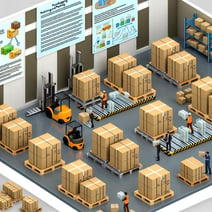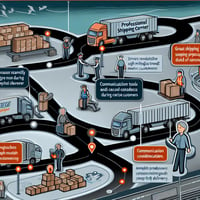Navigating the Maze of Modern Logistics with NESW Solutions Inc.
Top Strategies for Cutting Down Shipping Costs
Discover powerful strategies to reduce your freight costs and improve your bottom line.
Optimize packaging and palletizing
One of the most effective ways to reduce freight costs is by optimizing packaging and palletizing. This involves carefully selecting the right packaging materials and designs to maximize space utilization and minimize wasted space. By using compact and efficient packaging, you can fit more products into each shipment, reducing the number of shipments  required and ultimately lowering your overall freight costs.
required and ultimately lowering your overall freight costs.
Additionally, proper palletizing techniques can help optimize the loading and unloading process, ensuring that shipments are stacked securely and efficiently. This not only reduces the risk of damage during transit but also maximizes the use of available space, allowing for more efficient and cost-effective transportation.
By investing time and effort into optimizing packaging and palletizing practices, businesses can significantly reduce their freight costs and improve their bottom line.
Consolidate shipments and use freight pooling
Consolidating shipments and utilizing freight pooling are effective strategies for reducing freight costs. Instead of making multiple small shipments, businesses can combine multiple orders into a single shipment. This not only reduces transportation costs but also minimizes the environmental impact associated with transportation.
Freight pooling is another approach that involves combining shipments from different companies to achieve economies of scale. By sharing transportation resources and splitting the costs, businesses can benefit from lower shipping rates and reduced fuel consumption.
These strategies require effective coordination and communication with suppliers, customers, and logistics providers. However, the potential cost savings and environmental benefits make them worthwhile considerations for businesses looking to reduce their freight costs.
Utilize technology for route optimization
Technology plays a crucial role in optimizing freight routes and reducing shipping costs. Route optimization software uses algorithms to analyze various factors such as distance, traffic patterns, delivery schedules, and weight restrictions to determine the most efficient routes for transportation.
By utilizing this technology, businesses can minimize travel distance, reduce fuel consumption, and decrease transportation time. This not only leads to cost savings but also improves delivery performance and customer satisfaction.
Furthermore, real-time tracking and monitoring systems enable businesses to proactively identify and address any issues or delays during transit. This helps optimize operations, minimize disruptions, and ultimately reduce freight costs.
By embracing technology for route optimization, businesses can achieve significant cost savings and enhance their overall logistics efficiency.
Negotiate with carriers and leverage volume discounts
Negotiating with carriers and leveraging volume discounts is a proven strategy for reducing freight costs. By building strong relationships with carriers and demonstrating a consistent shipping volume, businesses can negotiate better rates and terms. You can also leverage the buying power of 3PL's to do this for you. 3PL's can also submit bids in your benefit to multiple carriers without the manual process.
It is important to proactively engage with carriers and 3PL's to discuss your shipping requirements, and explore opportunities for cost optimization. This may involve negotiating lower rates, securing volume discounts, or exploring alternative shipping options.
Additionally, businesses can consider collaborating with other companies to consolidate their shipping volumes and negotiate better rates collectively. This approach allows for increased bargaining power and access to more favorable pricing.
Regularly reviewing carrier contracts and exploring new partnership opportunities can help businesses continuously optimize their freight costs and improve their overall shipping efficiency.
Implement sustainable practices for cost savings
Implementing sustainable practices not only benefits the environment but also leads to significant cost savings in the long run. By reducing waste, optimizing energy usage, and adopting eco-friendly transportation methods, businesses can lower their freight costs and improve their sustainability performance.
For example, implementing recycling programs and using recyclable packaging materials can reduce waste disposal costs and contribute to a circular economy. Investing in energy-efficient vehicles and alternative fuel sources can help minimize fuel expenses and reduce carbon emissions.
Furthermore, businesses can explore greener transportation options such as rail or sea freight, which are often more cost-effective and environmentally friendly compared to air transport.
By integrating sustainable practices into their logistics operations, businesses can achieve cost savings, enhance their brand reputation, and contribute to a greener future.


